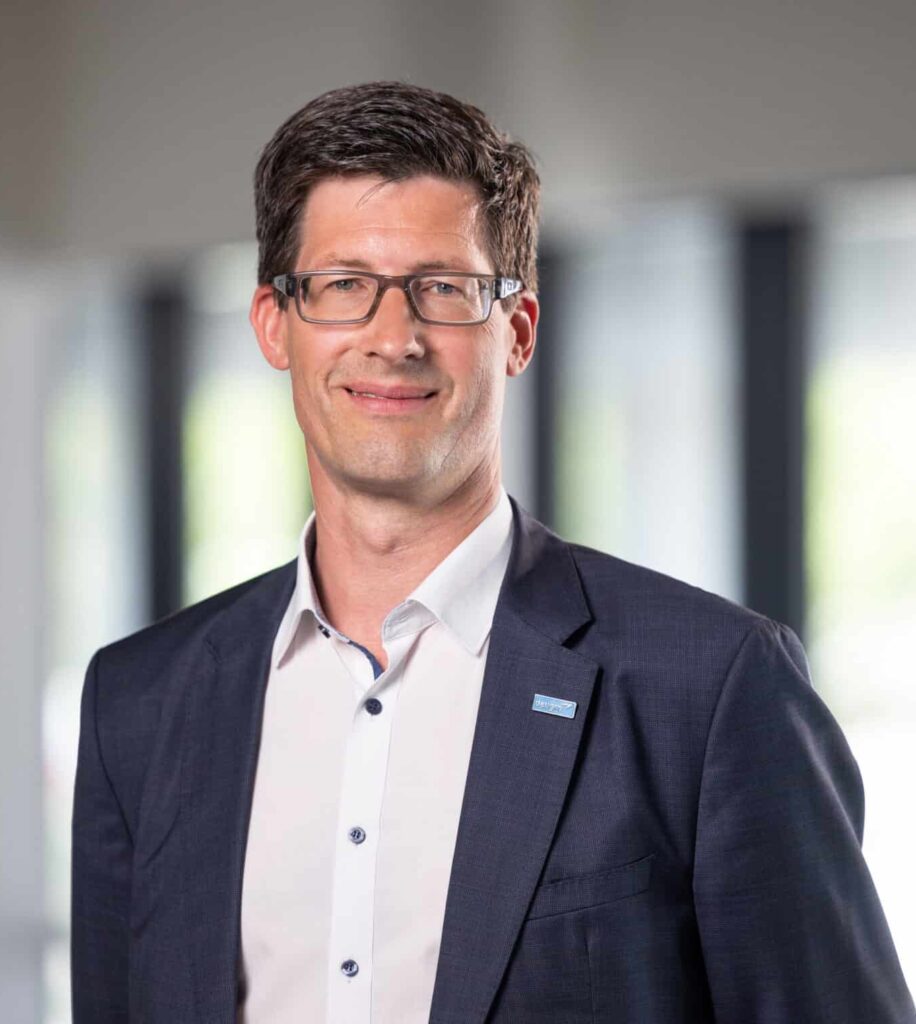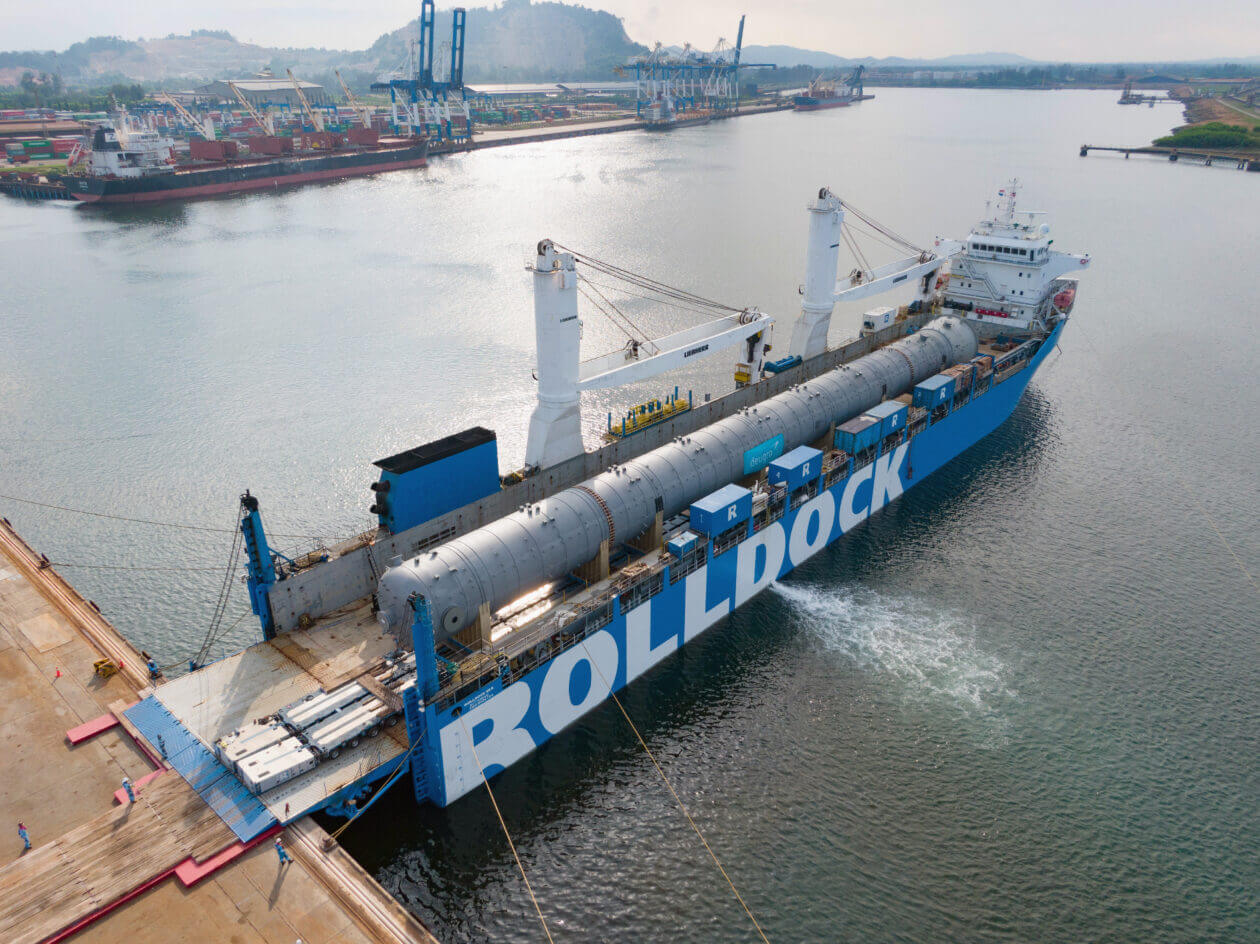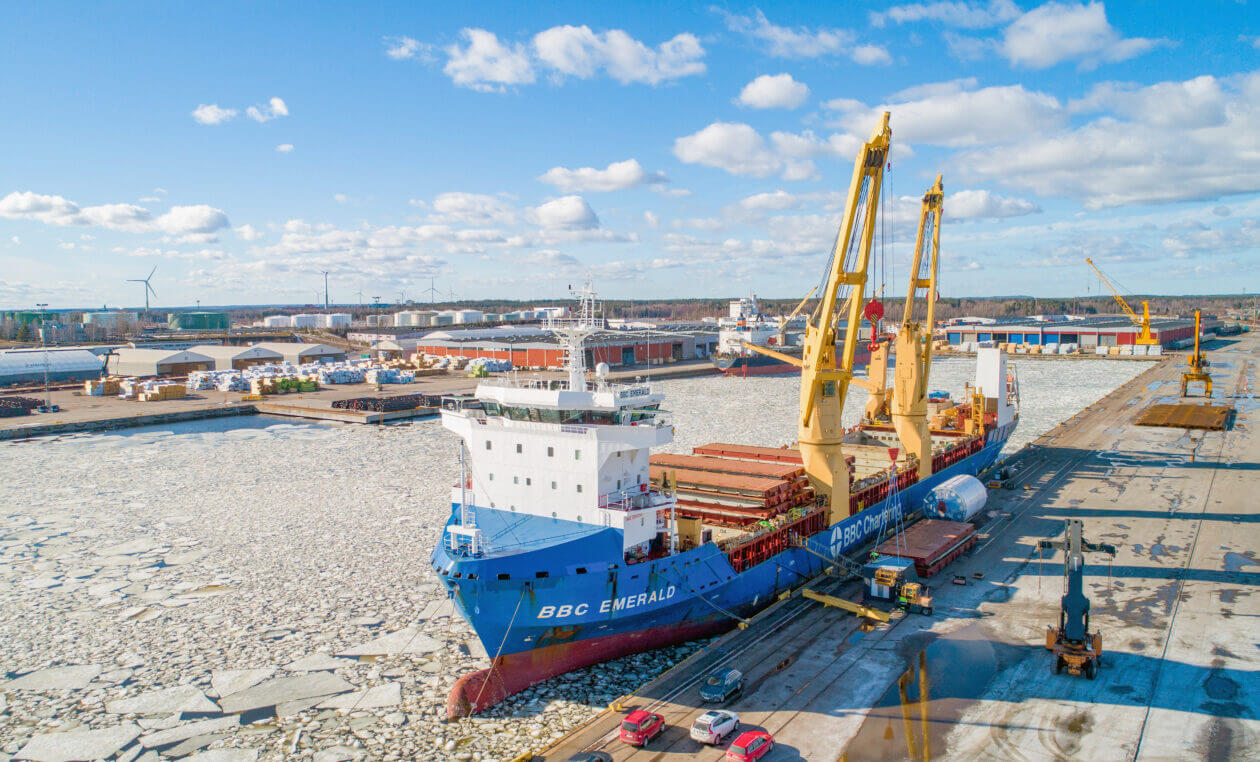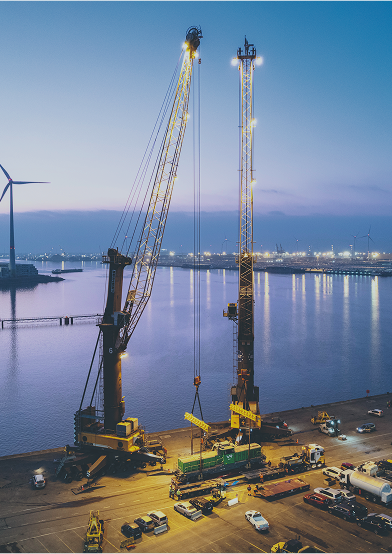Hi, Kai. Thanks a lot for taking the time to give us this interview. Can you shortly introduce yourself and tell us about your position and tasks at deugro Chartering, and about your past job or industry experience?
 Can you also shortly introduce your team?
Can you also shortly introduce your team?
KvT: Hi, thanks for having me today. I started my working life in shipping back in 2002 as an apprentice with the breakbulk and heavy lift carrier Rickmers-Linie. I stayed with that company until it became part of Zeamarine and finally went into insolvency in 2020. During my time with Rickmers and Zeamarine, I held various leading and managing roles and learned a lot about managing and operating breakbulk vessels in liner but also tramp services. I also had the opportunity to travel to many different countries and get to know the world at least a little bit. I never really lived abroad, but some of my trips lasted from several weeks to several months. I certainly spent most of my travel time in China.
Right after the insolvency of Zeamarine, I joined deugro as Head of Global Chartering. When I arrived at deugro, I found a fantastic Chartering team with great global coverage, but I could also see that the deugro organization was not making full use of the abilities and expertise of their own Chartering department. Because of this, we have developed the department—from a pure in-house broker into a department that is fully integrated in the deugro value chain. We not only provide our clients, which are mainly the deugro branch offices but occasionally also direct clients, with ocean freight quotations and shipping options, but also support them in evaluating the market, preparing forecasts for further market development, developing concepts for ocean transport and providing support with feed studies and tenders. We are also making more and more appearances in front of clients, partly through chartering webinars and seminars, but also in direct contact with clients, or as we say in chartering “head charterers,” where we support our colleagues with our expertise in direct discussions with clients.
When was deugro’s own Chartering department launched, and what are the advantages you offer clients?
KvT: The Chartering department was launched back in 2016. If I am not mistaken, it started with three people in Bremen. Today, we are a team of 12, spread over six locations, but with most team members still in Bremen. There are various advantages resulting from this set-up: First off, all enquiries are pooled via the Chartering department. This allows us to see whether we can put together any combinations of the various cargo from the different branch offices that are more attractive for the ocean carriers and thus help us to achieve more favorable rates. Most of the team members come from the carrier side and know exactly how to make cargo attractive to an ocean carrier.
This brings me to the second point: Channeling all inquiries through one department allows us to keep the quality of inquiries we are sending to the carrier at a high standard, which is very much appreciated by the carriers because it makes it easier for them to make an offer. At the same time, this also makes the Chartering department deugro’s face to the ocean carriers, who also appreciate dealing with counterparts that speak their “carrier language.” Of course, it is then also one of our tasks to translate this into “deugro language.”
Every year, the department works on more than 4,000 inquiries and over 450 vessel fixtures. On average, that’s about 16 enquiries and two bookings a day. As a result, we are of course in daily contact with most shipowners and therefore have a very good insight into the market as well as the current and medium-term trends. We share this knowledge with our colleagues and clients through our market report, webinars and seminars.
A very important advantage of the Chartering department is, of course, the expertise that is bundled in the department. Especially when it comes to negotiating the terms and conditions for a booking, further hidden costs and risks can lurk here. Mitigating these or at least indicating and evaluating them accordingly is another one of our many tasks.
Full and part charters are crucial and often challenging pieces of the puzzle for a successful project delivery. To ensure safe, efficient and successful project delivery within the schedule and budget right from the start, what must be considered from both your side and the client’s side regarding the chartering part?
KvT: It very much depends on the type of cargo and what kind of tonnage is required, and of course from where to where. If we are only dealing with simple general cargo moving on a major trade lane, we can count on a fairly large number of potential vessel candidates that are available to the market at relatively short prenotice. However, if we are dealing with particularly large or very heavy cargo units, or if we need transportation from one remote area to another remote area, the number of potential vessel candidates is somewhat or even significantly lower and lead times to secure this tonnage is getting much longer. When dealing with multiple shipment projects, we try to get the full understanding of the project requirements and ideally all cargo details. Based on that, we develop an execution concept that clearly defines what type of tonnage is required, which carriers are in control, and what the availability and booking lead time of this tonnage is. We also consider the pros and cons of different contract formats, including contracts of affreightment. However, the most important thing is to obtain as much detailed information as possible from our clients about cargo details, production and shipping schedules, and the required arrival dates, as well as quick and clear communication in case of changes.

For the Long Son project, in times of severely limited vessel and vessel space capacities due to the COVID-19 pandemic, altogether 55 heavy lift vessels were timely chartered to ensure the delivery of 155 breakbulk shipments.
Due to many advance bookings and in view of the increasing shortage of suitable heavy lift vessels with the appropriate capacity and equipment—the more complex, oversized and heavier the cargo becomes—how do you identify and secure the required vessel in the right place at the right time for clients?
KvT: Well, again it is all about proper communication. As soon as we know the cargo details, we can identify the number of suitable vessel candidates almost immediately and, of course, we also know the lead time required for securing such vessels or can find this out at short notice and guide our client about when a firm booking needs to be placed. Depending on the actual cargo but also port details, this can vary from just a couple of weeks to up to several months. If the cargo needs to be shipped on a deck carrier or semisubmersible vessel, the lead times for bookings are close to one year; and if the vessel must be equipped with a dynamic positioning system, even longer than that.
Due to the increasing demand for vessels and a shortage of supply, alternatives such as barges, coasters, etc. are increasingly being used whenever possible, for example in the short sea and offshore sector. Do you also offer such alternatives?
KvT: Of course we do. Being a project freight forwarder, we must always pursue two goals: On the one hand, we have to find the best technical transport solution. This means not only the most effective or safest way, but also the way that gives us the most flexibility and thus the ability to adapt to changes in the course of the project at short notice. On the other hand, this concept must of course also be cost-effective.
In chartering, we therefore not only look at traditional heavy lift tonnage, but also at virtually all vessel types. For general cargo, these are the traditional general cargo and heavy lift vessels as well as deck carriers and semisubmersible vessels, but also container and RO/RO vessels, as well as small coasters either with or without their own on-board cranes, and, of course, tug and barge solutions. We recently even had an offshore supply vessel to transport a few smaller parts over a short distance. We try to consider virtually everything that floats.

For the delivery of 263,300 FRT of cargo for the UPM Taurus Project in Uruguay, a total of 22 breakbulk vessels were identified and chartered.
To what extent do you include and consider port infrastructure surveys, pre- and on-carriage, loading and discharging, engineering, etc. in your services?
KvT: This is where we work closely with the responsible project management, because in Chartering, we purely focus on port to port only. We need the input from our colleagues on which ports should ideally be considered. Once we have that information, we get to work and check the port conditions and restrictions to ensure that the vessel type we have in mind can technically call at this port. It is not only about the water depth but also the number of suitable berths, the layout of the pier and if there is enough space to properly deliver the cargo to or receive the cargo from the ocean vessel. If a port limits the choice of ocean vessels too much due to certain restrictions, we look around for more suitable ports in the vicinity and suggest these to our colleagues, who then have to check the possibilities for pre- and on-carriage again.
In most cases, however, it is always the same ports and terminals where the cargo has to be handled, so that the details are generally known. Regarding engineering, we get some input from the heavy lift carriers which is then reviewed and eventually further refined by our sister company dteq Transport Engineering Solutions (dteq). dteq’s specialists cover a wide range of engineering services: from road surveys to stowage plans and method statements for loading with cranes or SPMT trailers or jack-and-slide solutions to mooring plans or motion analyses. There is almost nothing that dteq cannot cover itself; and as part of the deugro group, we can optimize our solutions with virtually no friction losses.
In global container transportation, the vessel’s sizes and loading capacities have continuously increased in recent years. What is the situation on the heavy lift vessel market?
KvT: Due to very difficult market conditions, we have had hardly any newbuilding activity in the breakbulk and heavy lift tonnage segment in the last 10 years, and therefore hardly any innovations in design. Only in the last three years have orders for new ships increased again thanks to the improved market situation from the shipowners’ point of view. And we can also observe an increase in loading capacities, although this is not necessarily due to the fact that the vessels are simply getting bigger, but rather due to changes in vessel design. For example, there are the superstructures with the command bridge, which were traditionally always at the vessel rear above the engine, but in almost all newbuildings that have been launched in recent years or will be launched soon, the superstructures and bridge are at the front. This means that cargo can now be stacked higher on the deck without blocking the view of the bridge crew, so the ship can carry more cargo.
The development of the engines is also exciting, as they are getting smaller and more fuel efficient and consequently require less space in the vessel for the engine itself but also the fuel tanks, so there is also more space for cargo below deck. The hatches are also getting longer and longer, allowing larger cargo items below deck. However, all this is also necessary, as the cargo itself is also getting larger and larger. For example, windmill blades. A good 20 years ago, such a blade was a “huge” 40 meters long. Today, people smile about this, because the blades of the latest offshore windmill generation are 150 meters long.

Do you also charter vessels or vessel space for containers?
KvT: Yes, at deugro we do because with almost every project we handle, we also see cargo moving in containers, or we even stuff the containers ourselves. This, however, is not handled by our Chartering department but by our deugro FCL Procurement department, helmed by Alhan Haq. This department was only established two years ago but has managed to build up a great reputation with many globally active container carriers. The FCL Procurement department is also our go-to place in case we want to ship breakbulk or project cargo on a container vessel.
Being in the industry for many years, where do you see the biggest changes in the business compared to the past, and can you give a personal estimation of further critical developments in the coming years?
KvT: Ha, if I had a reliable crystal ball, we wouldn’t be talking here now. Instead, I would probably be sitting on my private island in the Caribbean. But jokes aside, and of course happy to be here with you, shipping has always been a volatile business that is heavily dependent on political, geopolitical and thus also economic events. Weather also plays a major role, as it influences harvests and thus also cargo quantities and freight rates for certain shipping segments. Recent events such as the drought in Panama and thus restrictions on the use of the Panama Canal or the serious situation in the Red Sea, forcing vessels to take the longer route around Africa, or the cost explosion in shipbuilding have a direct impact on the availability and prices of ocean vessels, just to name a few examples. Unfortunately, it will always go on like this, and the only way to deal with it is to contractually protect yourself for all eventualities and, above all, to weigh up the possible risks carefully.
However, there is one change that is unfortunately already very evident and that is an impending imbalance between the decreasing supply of breakbulk and heavy lift tonnage and the increasing demand for transport capacity. The reason for the decreasing supply of vessels is the fact that the average age of the fleet is rapidly increasing. As of today, about 45% of breakbulk vessels that can lift at least 100 metric tons with their own cranes, which is actually not that much in the project cargo world, are already older than 15 years. However, many clients refuse to use vessels that are more than 15 years old, and thus lose access to almost half of the world’s fleet. Stricter environmental regulations can also lead to part of the fleet no longer being able to call at certain ports.
At the same time, we are currently seeing large quantities of cargo coming into the market and looking for transport capacity. First and foremost, these are still projects in the oil and gas industry, but also more and more projects in the field of renewables. Here we are not only talking about the classic windmill, but also about the associated foundations, technology for substations, offshore and onshore cables and so on. Also, one must not forget that, as already mentioned, the windmills are getting bigger and bigger. So, if 10 years ago a standard breakbulk vessel could transport three complete windmill sets at the same time, today it can only transport one set. All of this calls for more transport capacity. In turn, there is still very little newbuilding activity, as the cost of a breakbulk vessel has almost doubled in the last four years and the associated high financing seems too risky for many shipowners despite the current good market situation. Tonnage, which was available at short notice and inexpensively for many years, now has to be contracted in advance at higher prices. Last minute is no longer equally cheap for certain vessel types.
What are the advantages for clients of using deugro Chartering instead of going directly to the carriers?
KvT: From my point of view, there are an incredible number of advantages, but just to name the most important ones: At deugro Chartering, we work continuously with almost 90 different shipping companies. In addition, there is the container fleet, which we have access to through our FCL Procurement department. This gives us really high market coverage.
In addition, thanks to our global deugro organization, we are one of the project carriers’ top clients from their point of view, because we have cargo to offer on a regular basis and can consolidate it in part in the interest of the carriers, and therefore also have a little more buying power. This is partly reflected in the prices, but also partly in the terms and conditions.
Of course, it goes without saying that our chartering managers are very familiar with terms and conditions and negotiate them in the best-possible way in the interests of our clients, or they identify and analyze any resulting risks and suggest options for risk mitigation. Because of our activity level, we speak to all major ocean carriers at least twice a month; to some even several times per day. This allows us to gain a detailed insight into the market that hardly anyone else has and enables us to adapt our ocean transport concepts and strategies to current or expected conditions again and again. All this and much more, coupled with an understanding of the requirements of the projects and the clients, makes us a reliable but also innovative partner for ocean transport.
What are today’s main challenges in Chartering, and how do you face them?
KvT: As already mentioned, the shipping market is and remains vulnerable to many external influences and is thus very volatile. The associated shortage of tonnage, fluctuating freight rates and other operational problems are thus part of the usual day-to-day business of a chartering manager, so to speak. Yet with our deugro Chartering department as well as the deugro FCL Procurement department, we are well positioned to deal with these challenges.
However, a major problem is not only the lack of young talent for this highly specialized sector, which we see as a problem on the part of both freight forwarders and shipping companies, but also the dwindling expertise and understanding among end clients. Unfortunately, this lack of understanding often leads to decisions not being made within the necessary timeframe or by considering all the information. Often, a decision is simply made in favor of the cheapest price, but this can then lead to higher ancillary costs and thus an overrun of the budget in the course of a project. Therefore, I can only repeat myself here: The key to the success of a project, including the appropriate handling of ocean transports, is transparent and timely communication, considering the contractual conditions and all technical options.
In order to provide the best-possible support, we offer a series of courses both internally and externally, which can be held either as seminars or webinars and which deal with simple or sometimes more complex chartering topics as well as with in-depth insights into the general shipping market. In this way, we try to convey a better understanding of the overall situation so that all parties can make the best-possible decisions in the interest of the project.
Thank you very much for your insights.
KvT: Thank you for having me. Always appreciated!
